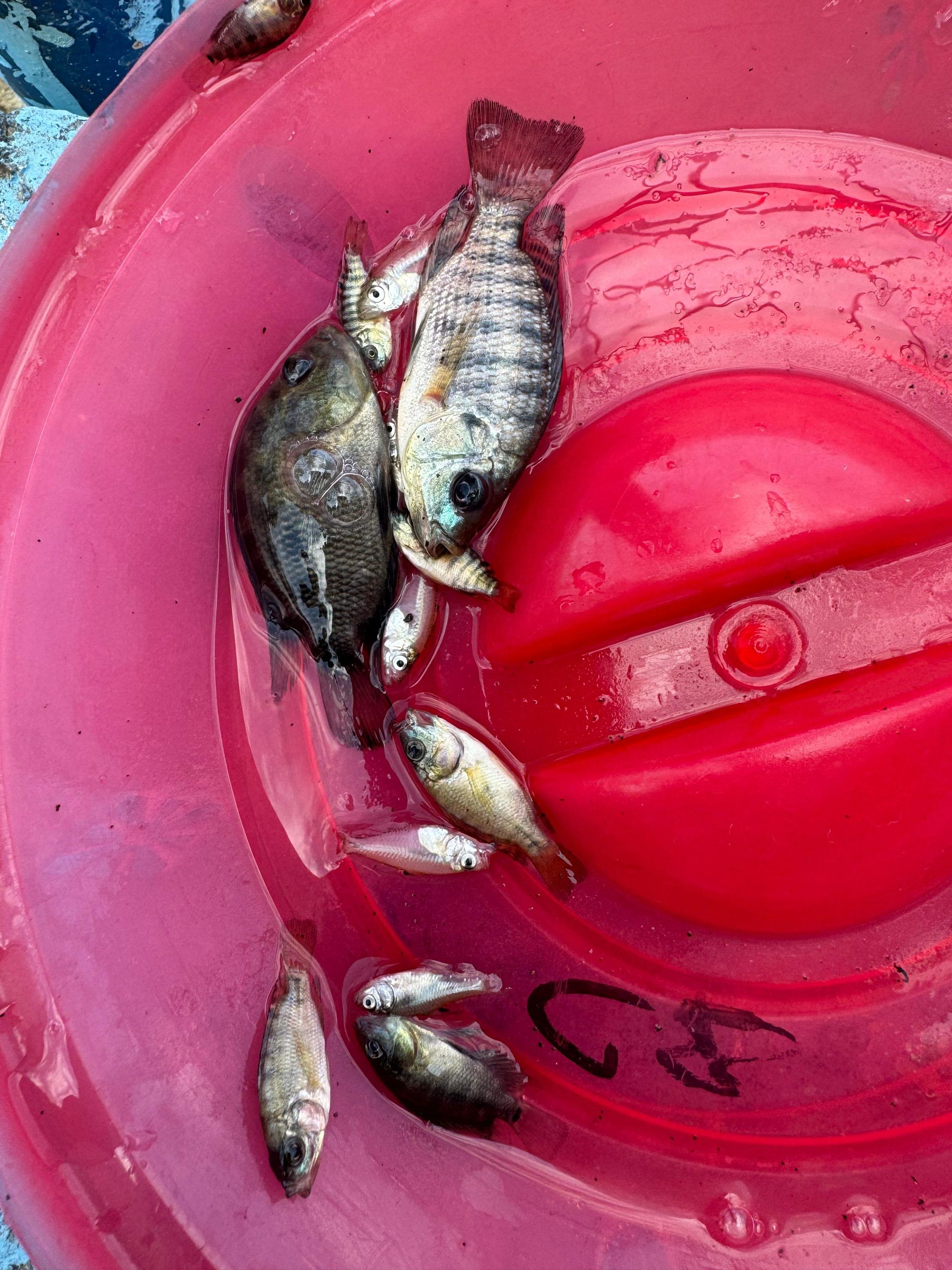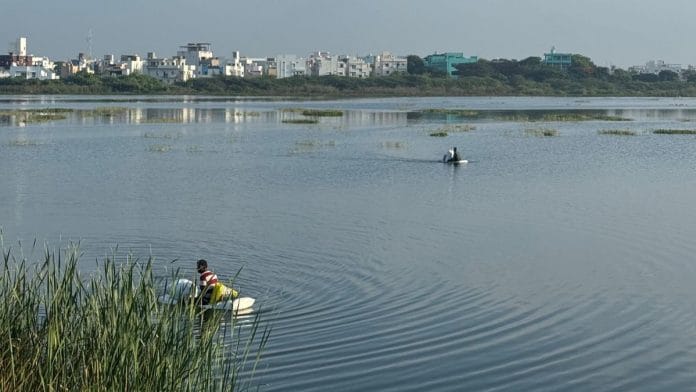Chennai: Armed with fishing and mosquito nets, 28-year-old IT entrepreneur Kharthickeyen KS and his friend and IT professional Beta Mahatvaraj decided to spend their Sunday morning at western Chennai’s Korattur Lake, spread over 990 acres. They weren’t fishing. The duo simply surveyed the catch of the local fishermen and what came in their own net — noting down the species before releasing them into the fresh water. It was the presence of invasive fish species that filled them with concern.
Among the native varieties such as GlassFish, a ‘near threatened’ species, Elongate Glassy Perchlet, Pencil Fish and Green side Barb were present the invasive ones: Tilapia, Mosquito Fish (native to North America), Sucker Mouth Catfish (native to South America), among others.
“They are a threat to native species. Fish like Plecostomus, which can burrow into the earth, can disrupt the entire ecosystem as they compromise the lake’s existing ecology,” said the 45-year-old Beta Mahatvaraj.
Invasive species are climate resilient and highly adaptable to new environment. They can consume the food sources in an ecosystem and outcompete the native varieties. The alien species breed more compared to the native ones resulting in a higher population. The Korattur Lake is also infested with Tilapia, mosquito fish, flowerhorn Cichilid, and Midas Cichlid. While Tilapia is edible, most invasive species are inedible and have no significant economic benefits.

The presence of invasive fish in Korattur Lake has now reached the environment court with the National Green Tribunal taking suo motu cognizance of a newspaper report that mentioned the survey findings by Kharthickeyen and Mahatvaraj. The survey highlights a silent problem being faced by freshwater fish species that are at risk of extinction. The court has asked the state government to take necessary action to remove the invasive species. Korattur is not an isolated case. As per the 2020 report by the Ministry of Fisheries, the overpopulation of the species affected several reservoirs and lakes, including Vaigai, Krishnagiri, Amaravati, Bhavanisagar, Tirumoorthy, Upper and Pambar reservoirs in Tamil Nadu, Walayar, Malampuzha, Pothundy, Meenkara, Chulliar and Peechi reservoirs of Kerala, Kabini reservoir of Karnataka and Jaisamand Lake of Rajasthan.
Also read: Govt job in Jharkhand means corruption, cheating, exam delays, court cases—JPSC to JSSC
The missing policy
Mahatvaraj has been documenting and studying fish in the Western and Eastern ghats area, particularly in Tamil Nadu and Kerala. He undertakes such exercises both independently and in collaboration with different groups such as the Central Inland Fisheries Research Institute (CIFRI).
A global assessment by the International Union for Conservation of Nature (IUCN) in 2023 revealed that 25 per cent of the total freshwater fish species are at risk of extinction due to climate change, pollution and changing water levels. As per the study, 33 per cent of the fish species are affected by alien varieties.
Invasive species are introduced outside their natural habitat accidentally during floods, natural calamities and sometimes even intentionally to tackle issues such as mosquito menace or for edible purposes, said Mahatvaraj.
However, there are very few places in the country where initiatives have been launched to fight this menace. The forest departments of Keoladeo National Park in Rajasthan and Periyar Tiger Reserve in Kerala are working towards it.
A global assessment by the International Union for Conservation of Nature (IUCN) in 2023 revealed that 25 per cent of the total freshwater fish species are at risk of extinction due to climate change, pollution and changing water levels. As per the study, 33 per cent of the fish species are affected by alien varieties.
And the job of getting rid of the foreign body is a painful and slow exercise.
Dr VS Basheer, scientist at CIFRI, said that India needs a comprehensive policy at state or central level to ensure regular removal of alien fish species and keep water bodies safe.
“We have to remove them physically to tackle their population,” said Basheer.
Their survey, said Kharthickeyen, is just the tip of the iceberg. The duo said there needs to be more such surveys across all waterbodies in Chennai and outside to understand local biodiversity and its preservation.
“A similar study on Chennai’s Cooum, the most polluted river in the country, can help in reviving the river itself,” said Kharthickeyen.
Originating in Tiruvallur district, 70 km away from Chennai, the Cooum river becomes highly polluted as it enters urban Chennai due to the discharge of sewage and encroachments. As per the Waterbodies Census report by the National Institute of Urban Affairs, Tamil Nadu has the highest number of natural water bodies in urban areas.
However, despite the abundance of natural water bodies, the state faces water scarcity in certain regions due to urbanisation and overexploitation of water resources. While there have been many studies and actions on invasive plant species in the state, the Tamil Nadu government has never looked at aquatic life with the same lens. The state was the first in India to introduce a policy to manage invasive plant species, but the Tamil Nadu Policy on Invasive Plants and Ecological Restoration (TNPIPER) didn’t find mention of invasive fishes.

Also read: Nitish Katara murder witness battles 37 cases, bullets, poison—Ajay Katara a cautionary tale
A once thriving lake
The Korattur lake that once quenched a parched Chennai was the primary source of drinking water for the surrounding seven villages till the late 1980s, recalled Sekaran, resident and secretary of Korattur Aeri Pathukapu Makkal Iyakkam (KAPMI), a volunteer group working to restore the lake.
As the years passed, the area around the lake was encroached completely by construction, and the sewage from the nearby Ambattur industrial estate polluted its water, forcing the local people to start a campaign for its revival.
At least 200 families are still dependent on fishing in the lake for their livelihood.
“We used to catch abundant varaal (snakehead murrel), native Tilapia, and Velichi meen (Indian anchovy),” said 50-year-old D Saravanakumar, a local fisherman. The fisherfolk, who used to earn up to Rs 5,000 a day are now earning Rs 1,000 or less. Saravanakumar said many shrimp varieties have slowly become extinct from the lake in the past two decades.
“We are trying to contribute what we know to build a community knowledge,” said Kharthickeyen. The study was aimed at empowering the local fishermen community as their lives are directly dependent on it.
Once a centre of their lives, the dying lake has forced hundreds like Sivaraman to find alternate source of income – cattle rearing and working at kilns. Sivaraman reminisces about the good old days.
“My grandfather had set up a small temple near the lake. When we were young, hundreds would gather there to pray before going fishing,” he said, recalling a much cleaner water body lake that held a community together.
Also read: India’s youngest spiritual baba wants no friends, smartphones. What about homework, people ask
A local campaign, city scientists
A 2015 report published in the Journal of Threatened Taxa revealed the existence of two invasive species, Trichopsis Vittata and Macropodus Opercularis, belonging to the Osphronemidae family, in the Chembarambakkam and Red Hills lakes, respectively. Located in the western and northern parts of Chennai, these rain-fed lakes are the source of the city’s drinking water.
While the study on Chembarambakkam and Red Hills waters was done by scientists with professional knowledge in the field, the Korattur cause is seeing the coming together of citizens with similar enthusiasm to undertake such an initiative.
Kharthickeyen uses satellite images to understand the evolution of water bodies such as Korattur over the years — changes to total area of greenery, and the area with water if that has shrunk overtime or increased etc.
“Once you make the locals aware about the life in their waterbodies, they will make the government accountable for its revival,” Kharthickeyen said, adding that the study on aquatic life will give us the idea of water cycle itself and its quality.
Kharthickeyen uses satellite images to understand the evolution of water bodies such as Korattur over the years — changes to total area of greenery, and the area with water if that has shrunk overtime or increased etc.
The challenge of identifying invasive fish in local ecosystem becomes difficult because even the fishers’ knowledge of the fauna is not authentic.
“Many think Tilapia is a native variety,” said Kharthckeyen. Native to Africa, Tilapia was introduced in Indian waters in 1952 to boost food security. Tilapia adapts to different environments quickly and has high breeding capacity, so it was used for commercial aquaculture in India. The species spread across the country within a few years due to its prolific breeding capability and adaptability to a wide range of environmental conditions.
Scientists say that only Rajasthan and Kerala had done this till now in India, but there too they didn’t continue to do it after the first time. Rajasthan introduced a 10-year project to remove African catfish in 2016. In Kerala, the Periyar Tiger Reserve did the removal project independently.
Mahatvaraj, who has been running a Facebook and YouTube channel called Meenkaran (fisherman) has been documenting many fish varieties over the years and is now working on a book on fish in Chennai, collaborating with Aravind Manoj, a 27-year-old software developer.
Living in different parts of the city doing different jobs, the three (Mahatvaraj, Manoj and Kharthickeyen) share one common interest, their love for fish and conservation. The three IT professionals became friends through social media.
“I was a wildlife enthusiast since childhood. But later I understood that nobody is interested in fish,” said Aravind, adding that he contacted Mahatvaraj through Facebook four years ago.
“If I have any doubts regarding fish, I text him,” said Manoj who goes on fishing trips across Chennai at least once a month to understand the local fauna. Due to the lack of knowledge, he said, many people get offended when they see us kill invasive species.
Despite their keen interest in conservation, Mahatvaraj, Kharthckeyen and Mahatvaraj don’t have the answer to this problem.
But thousands of kilometres away in Mexico, a company is making dog treats out of invasive fish. Berkeley-based Pezzy Pets has tied up with small scale fishermen in US, Mexico and Caribbean, sourcing invasive fish from them and making pet food.
(Edited by Anurag Chaubey)






